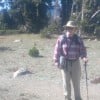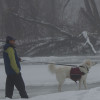Geoengineering to head off an impending supervolcano explosion?
More than 70 thousand years ago, the Toba Supervolcano (Indonesia) blew its top, and sent the planet into a long Volcanic Winter. Although there are huge uncertainties in this number, some scientists estimate that 90% of all people alive at the time perished, because they could not adapt quickly enough to the instantaneous, medium-term climate change.
Suppose that geophysics knowledge increases dramatically in the near future. Suppose further that geophysicists reach a consensus that the Long Valley Caldera ( a supervolcano in California) is about to have another mega-explosion. Which options should policy-makers explore?
My educated guess is that they would do their best to bury the story, and do nothing, aside from constructing well-stocked bunkers for themselves and their families. For some odd reason, their Chicken Little routine is always reserved for non-problems, like Anthropogenic Global Warming.
Here's my Politically Incorrect option. Drill a number of deep holes at strategic locations. Put a 2-megaton nuke at the bottom of each hole. Then detonate all of them simultaneously. Why?
It would relieve most of the built-up pressure. The radioactive fallout would be far less deadly to humankind, and to The Planet, than a full-house supervolcanic mega-explosion.
What do you think? (Blanket claims that anything nuke-yuh-lar is automatically 'evil' do not add to the discussion.)If your nukes are near enough Toba to relieve pressure, they are also close enough to add pressure. Detonating them simultaneously seems more like it would cause Toba to off with twice the violence.
Picture a closed barrel of water, with a weak spot. Add a stick of dynamite and set it off inside. It will blow a hole near where it is, but also at the weak spot.Hi wilderness,
Thanks for your comment. The water barrel analogy is interesting.
A revolver is my tacit model. Fire 2 rounds. The first is a standard factory load. The second is similar, but the lead bullet is replaced with an equal volume of styrofoam.
At point blank range, either load could cause considerable damage to ballistic gelatin. But at 5 yards, the bullet would be far more injurious than the styrofoam.
With or without the nukes, the explosion would take out any overhead aircraft whose pilots ignored the warnings. That's the equivalent of shooting a revolver at point blank range.
The idea behind the nuclear mitigation is to create a partially open channel for the hot pressurized gases (including steam) to escape. In principle, it's similar to the styrofoam bullet.
The damage done by a real Supervolcano is partly due to the mass of rock that's pulverized and ejected. With nuclear mitigation, less rock would be blown to smithereens. That translates into less volcanic ash burying people, cars, houses, and food crops.
More to the point, less volcanic ash would find its way into the upper reaches of the atmosphere. The Volcanic Winter--if any--would be considerably shorter.
By the way, the nukes would add a RELATIVELY small amount of energy to the system. We're not talking about a piddling Mt Pinatubo explosion here.
It would be nice if we could accomplish the same objective with drilling alone. But with increasing temperatures at increasing depth, at some point, the drilling equipment would cease to function. Realistically, the mitigation effect of drilling alone would be considerably smaller than that of the drilling + nuclear plan.The problem with a gun is that it is not a closed system as underground magma is. Rather it is completely open, using styrofoam or lead bullets striking a target. No comparison at all can be made.
The energy of an underground nuke cannot escape fast enough via a drill hole; it will thus pressurize the (liquid) magma. Pressurizing a liquid puts equal pressure at all points; Toba blows it's the top that is already weak.
Hi paradigmsearch,
I appreciate the creativity of your proposal. But wouldn't that make the event even more CATastrophic? Oh, bad pun! Bad Larry! *slaps self on wrist*
I see a bigger problem. That is in extraction of so much oil. My civil engineering suggests that oil rock reservoirs may sink. In other words, your nukes may further cause earth to collapse inwards.
Hi Suhail,
Good question. With or without the nukes, a supervolcanic explosion could affect oil rock reservoirs. Without doing more homework, I can give only a partial answer.
50 years ago, there were oil derricks in SW California. I do not know about conventional oil in the rest of the state.
In particular, I do not know about the region near the Long Valley Caldera in the Eastern part of California. I do know that there are desert mountain ranges to the East, which parallel the Sierras. These include the White Mountains, and the Inyos further to the South. (By the way, there's a good area in the Inyos for finding Cambrian fossils.)
Although I'm not knowledgeable about petroleum geology, I would not expect to find conventional oil in the mountainous areas near the LVC. Owens Valley, between the Sierras and the desert ranges, may be a different ball of wax. I don't know about that.
Anyway, I was fortunate to have chosen the LVC as an example. Supervolcanoes in other parts of the world may be a different story. Sorry I can't give a more definitive answer to your question.
Supervolcanoes in other parts of the world may be a different story. Sorry I can't give a more definitive answer to your question.
Related Discussions
- 12
Why are baby boomers simultaneously so critical of parenting and such bad parent
by ParadigmEnacted 12 years ago
Why are baby boomers simultaneously so critical of parenting and such bad parents themselves?
- 32
How is the world going to end?
by Luke M. Simmons 6 years ago
How is the world going to end?I guess the real question would be, what do you think will cause the extinction of the human species or the death of a significantly large portion of it? Will it be infrastructure collapse due to our lack of preparation for a CME? How about societal upheaval in...
- 46
The Global Warming Scam has failed. Time for Global Cooling . .
by sannyasinman 15 years ago
Global Cooling and the New World Order ... http://blogs.telegraph.co.uk/news/james … rld-order/
- 10
Solar Geoengineering - Good or Bad or Somewhere in Between?
by Scott Belford 2 years ago
A way to combat climate change which is new to me is Solar Geoengineering - reducing the amount of the sun's energy from warming the planet.Some see it as a panacea for what we are doing to ourselves while others see it as the end of the world." When Mount Pinatubo erupted in the Philippines...
- 11
What is the root cause of Global Warming -- Greenhouse Gases, Bad Lifestyle or L
by Goodpal 12 years ago
What is the root cause of Global Warming -- Greenhouse Gases, Bad Lifestyle or Lack of Money?People blame greenhouse gases - CO2, methane, etc - for global warming and climate change problems. In my opinion, these gases are the symptoms of the problem, the root cause lies in the modern lifestyle...
- 32
We have apparently entered an era of scientific denial!
by Ralph Deeds 12 years ago
" ROCHESTER — IN 1982, polls showed that 44 percent of Americans believed God had created human beings in their present form. Thirty years later, the fraction of the population who are creationists is 46 percent. "In 1989, when “climate change” had just entered the public...









